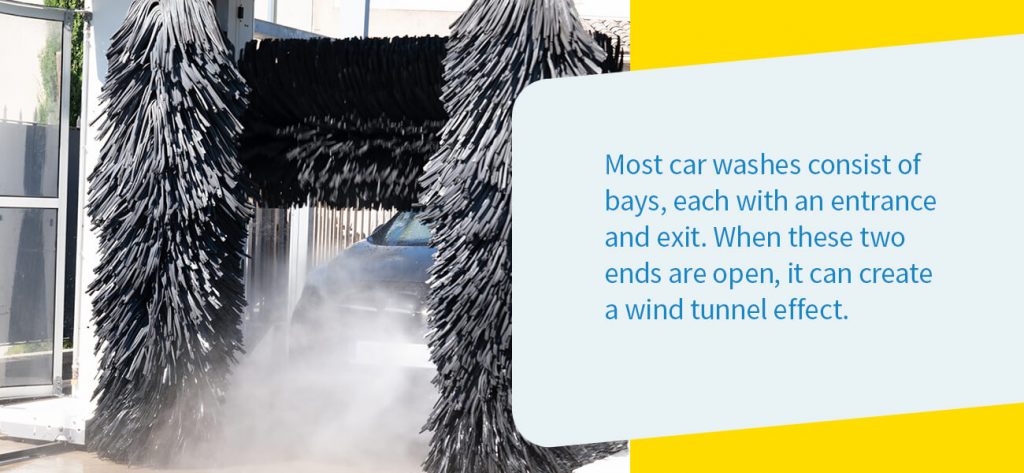How to Protect Your Car Wash From High Winds
With spraying water and a blow dryer, the inside of a car wash can mimic a storm — one that leaves your customers’ cars clean and shiny when they drive off. But what if there’s just as much precipitation and moving air outside the car wash bay as there is inside? Storms are a common occurrence, and in many cases, the worst consequence for a car wash will be slow business while it’s storming.
However, some weather events can cause bigger problems. High winds, for example, can damage parts of your car wash, especially if you’re not prepared for these conditions. We’ll discuss how to prevent wind damage and what you should do when wind damage occurs. Preventative measures to protect from windstorms can help you avoid damage altogether or at least minimize it so you can steer clear of costly repairs and stay open for business.
Contact Us For Your Car Wash Supply Needs
What Is Wind Damage?
Wind may be invisible, but it can have some very real, tangible effects. When air is moving especially fast, these strong winds can blow objects over and cause significant levels of destruction. Damaging winds often accompany other severe weather events, like thunderstorms, hurricanes or tornadoes. Depending on where your business is located, you may or may not be at a high risk of experiencing hurricanes or tornadoes, but thunderstorms are a common occurrence throughout the U.S. Thunderstorm winds are called straight-line winds to differentiate from rotating tornadic winds.
Winds are classified according to their speed and the level of threat they pose. The National Weather Service puts out a high wind warning when winds have speeds of 40 mph or greater for more than an hour or if there are wind gusts reaching at least 58 mph. Winds are classified as damaging winds if they exceed 50-60 mph.
In severe thunderstorms, wind speeds can reach speeds of 100 mph and cause widespread damage. Wind damage may take the form of fallen trees or downed utility poles, which can damage buildings or other objects they strike on their way down. Winds can also blow open doors and windows and even pry off roof shingles.
Meteorologists classify damaging winds into various types, including:
- Downdraft: When a column of air rapidly descends toward the ground, it’s known as a downdraft. When this air hits the ground, it can cause either a macroburst or a microburst.
- Macroburst: When a downdraft hits the ground and spreads out, this is often referred to as a downburst. When a downburst covers an area of 2.5 miles or more, this is known as a macroburst. Macrobursts can cause damage similar to tornado damage.
- Microburst: When a downdraft results in a short-lived burst — no longer than 10 minutes — that is not as widespread, this is known as a microburst. Microbursts can be either wet or dry. Wet microbursts include heavy precipitation, while dry microbursts are limited to wind gusts with little to no precipitation.
- Haboob: When a downdraft hits the ground, it can blow up dirt, causing a blanket of dust to extend outward. These instances are known as haboobs and are more common in dryland regions.
- Gust fronts: When rain-cooled air encounters warmer thunderstorm inflow, this clash results in gust fronts — dangerously gusty winds that go ahead of a thunderstorm. Some gust fronts, nicknamed “gustnadoes,” mimic the conditions of a tornado but are weaker.
- Derechos: Sometimes, widespread and enduring windstorms are classified as derechos. Derechos cover an area of more than 240 miles and feature wind gusts of at least 58 mph throughout most of its length. Derechos tend to include multiple instances of downbursts and downburst clusters.
Whatever the subclass, damaging winds can wreak havoc on your car wash if you haven’t prepared for this scenario. According to one study, business insurance claims for wind or hail damage average $26,000 each, showing just how expensive wind damage can be. If your car wash is damaged in a storm, this may also force you to close for repairs, adding even more to the consequences of the storm.
10 Ways You Can Protect Your Car Wash From Wind Damage
Fortunately, you can take steps to protect your car wash business from damaging winds. Below, we’ll look at how to prevent wind damage. Most of these tips are actions you can take right now to protect your business. There’s no need to wait until the weather forecast looks daunting to get prepared.
1. Install Doors on Car Wash Bays
First, if your car wash is not equipped with doors, you should consider installing some. Most car washes consist of bays, each with an entrance and exit. When these two ends are open, it can create a wind tunnel effect. Even when winds are not particularly high outside, this wind tunnel effect can be problematic since it can cause cleaning chemicals and water to blow away, interfering with the cleaning process. For manual car washes, doors also provide some shelter in the bay, which can be helpful, especially when it is cold outside.
When it comes to windstorms, open-ended bays can cause even greater problems. Cars, equipment and — most importantly — people in car wash bays will all be safer if there are doors on either end to close them in during a windstorm.
2. Equip Doors With Locking Devices
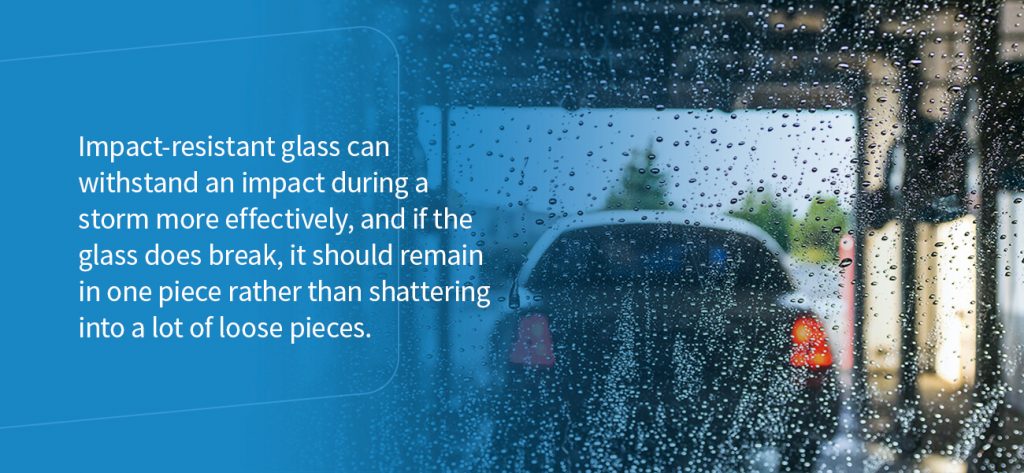
Whether you’re installing doors or you already have doors on your car wash bays, you should also think about how to secure them. Especially if you live in an area where damaging winds are a common occurrence, you’ve probably equipped your garage door at home with some sort of locking mechanism to keep it shut in the face of high winds.
Similar devices can work well for overhead car wash doors. A locking mechanism should either run across the whole door or should cover the upper and lower parts of the frame to keep the door from blowing out during a severe storm. If you have a waiting room or office area with a front door, you should also make sure these doors are secured with proper locks and feature door stops to keep them from swinging open uncontrollably.
3. Opt for Impact-Resistant Windows
When high winds pick up branches or other debris and these projectiles hit a glass window or door, the impact could shatter the glass and allow more debris and precipitation to blow into your facility. These instances can result in expensive repairs and pose a safety risk to anyone inside or nearby. The solution is impact-resistant doors and windows made of laminated glass panes.
Impact-resistant glass can withstand an impact during a storm more effectively, and if the glass does break, it should remain in one piece rather than shattering into a lot of loose pieces. This sturdy option will help prevent hazardous cleanup of broken and scattered pieces of glass if something does hit your window. Windows made of impact-resistant glass may also be called hurricane-resistant windows or simply impact windows.
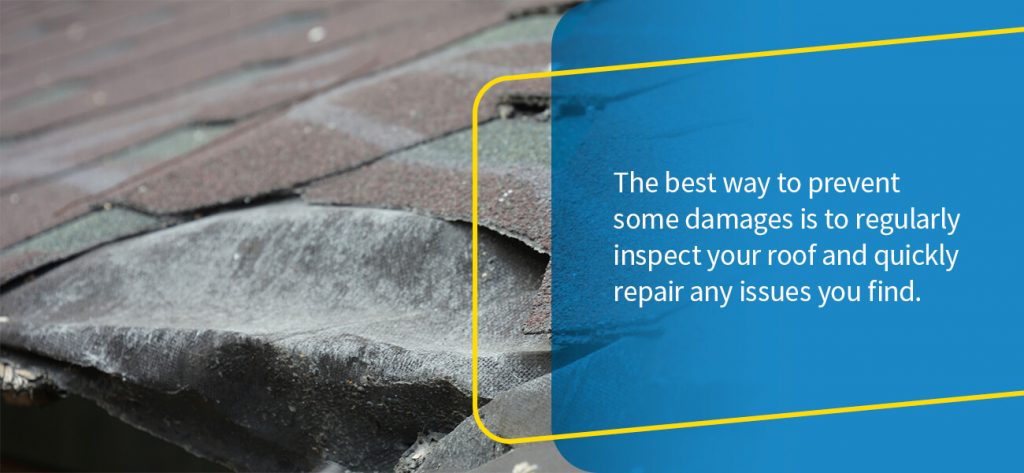
4. Conduct Regular Rooftop Inspections
After a severe storm, you may have noticed many homes and commercial buildings in the area with tarps over the roof. Rooftop damage is a common problem high winds cause. While some rooftop damage comes from falling objects, the wind itself can also directly cause damage by ripping up shingles. This problem tends to affect a roof’s edges and any loose shingles on the roof. Metal roofs tend to resist wind damage more effectively.
While some storms may be destructive enough to affect a shingle or tile roof that’s in good shape, in many instances, damaging winds will reveal there were already weak spots on a roof. The best way to prevent this damage is to regularly inspect your roof and quickly repair any issues you find. Look for loose shingles or other problems. You should also check rooftop equipment, such as wash pumps, to make sure everything is well-secured and is not at risk of flying off during strong winds.
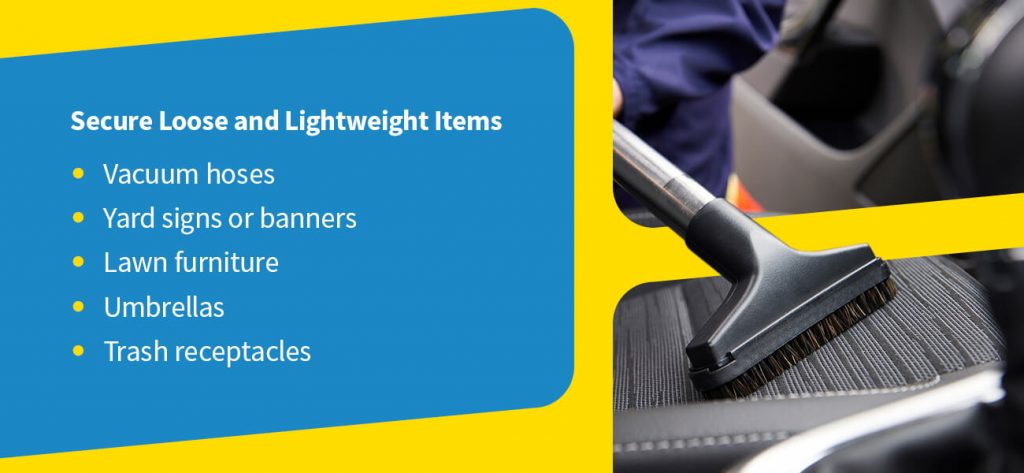
5. Secure Loose and Lightweight Items
Any items that are loose or lightweight are likely to become airborne during a windstorm. This could include, for example:
- Vacuum hoses
- Yard signs or banners
- Lawn furniture
- Umbrellas
- Trash receptacles
All of these items can go flying, becoming damaged themselves and causing damage to anything they strike if they aren’t properly secured before a storm. If you’re expecting some severe winds, you should bring loose items inside or place them in a secure storage box or shed outside if possible. For items that must stay out but are at risk of blowing around, take steps to secure them in place. For example, you could use a bungee cord to keep a vacuum hose in place.
6. Keep Debris Cleared Away
You probably wouldn’t think twice about pebbles in your parking lot. But during a windstorm, those and other small items like litter can get picked up and cause injuries to anyone in their path or cause damage to surfaces they strike. A business that sells cleanliness should always strive to keep the property sparkling, but it’s especially important to clear away debris before a storm.
Try to make sweeping a daily task to ensure your parking lot and car wash areas are kept clean. Especially if a storm is on the horizon, clear away any bits of debris, including pebbles, twigs and trash. If you’re noticing trash collecting in your parking lot regularly, you should consider adding additional trash cans to ensure it’s convenient for customers to dispose of trash properly.
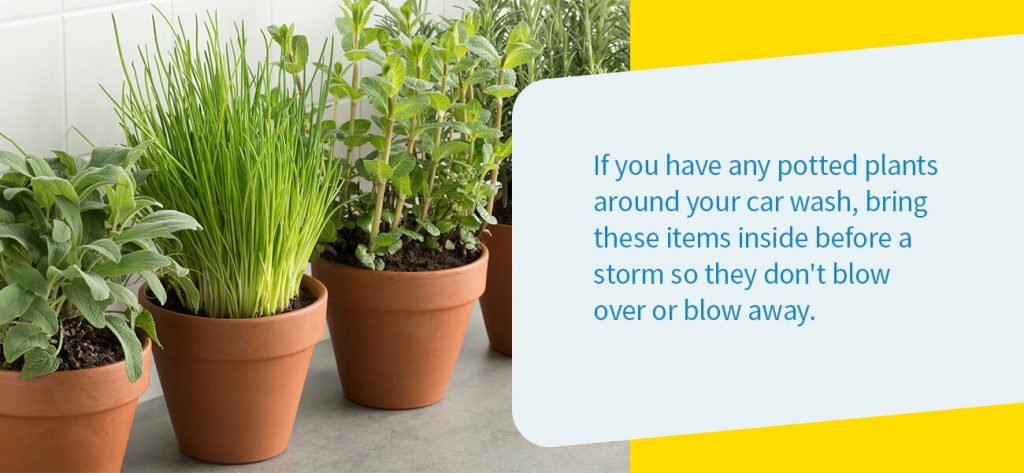
7. Maintain Landscaping Around the Car Wash
You should also assess the landscaping around your car wash and ensure it’s well-maintained. The biggest dangers are trees that could fall over and strike your car wash roof or parking lot. Trees that appear to be leaning or are overreaching your building or power lines should be removed or trimmed back as needed. Keeping trees pruned also makes your landscaping look more attractive and well cared for.
You should also trim any trees or shrubs with dead branches. Otherwise, these branches could break off and cause damage during a storm. If you have any potted plants around your car wash, bring these items inside before a storm so they don’t blow over or blow away.
8. Have an Emergency Preparedness Plan
A severe storm can be a real safety emergency, so it’s smart to create an emergency preparedness plan so you and your employees know exactly what to do in the event of a severe weather event. This plan should include information on:
- Where employees should shelter in place during severe weather
- What conditions would necessitate shutting down operations temporarily
- What steps employees need to take just before a storm to prevent damage to the car wash
The U.S. government provides online resources to help individuals and business owners create emergency preparedness plans. Be sure to post your plan in a visible location inside your car wash for reference.
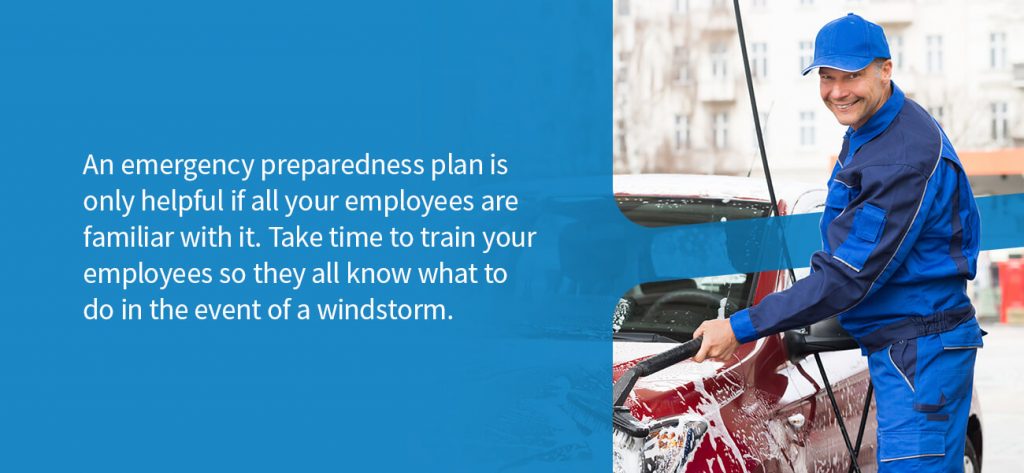
9. Train Employees on Emergency Plans
An emergency preparedness plan is only helpful if all your employees are familiar with it. Take time to train your employees so they all know what to do in the event of a windstorm. Waiting until a storm is on its way to pull out the emergency plan is never a good idea.
Instead, employees should learn about evacuation, securing items and other important procedures when all is well so when a storm hits, they won’t have to pause to learn about the plan — they’ll be ready for action. Be sure to train new employees on this plan, retrain the rest of your staff and update the plan as necessary.
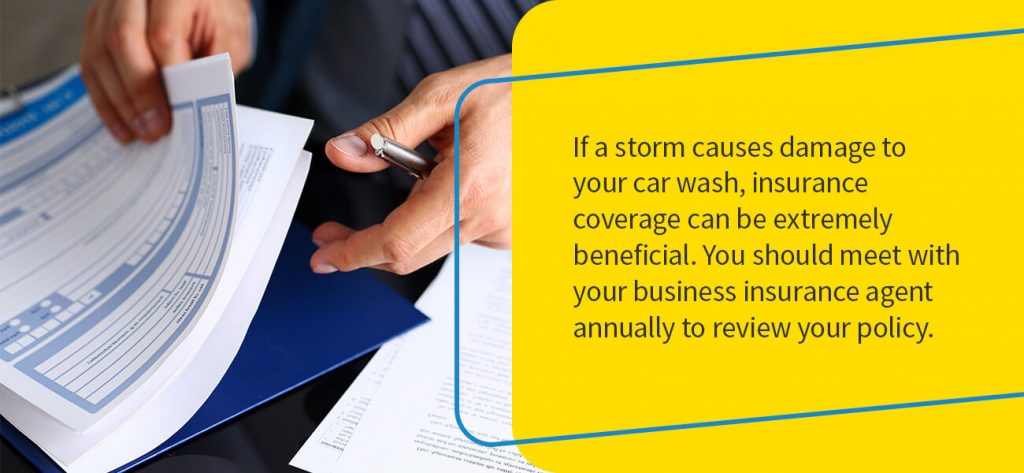
10. Familiarize Yourself With Your Insurance Policy
If a storm causes damage to your car wash, insurance coverage can be extremely beneficial. But do you know if your current insurance policies cover severe weather damage or wind damage? Commercial property insurance typically covers damage from windstorms. However, if your car wash is in an area where hurricanes are common, wind damage may not be covered by a standard policy. Instead, you must get additional coverage for hurricanes and other types of damaging winds.
You should meet with your business insurance agent annually to review your policy. This way, you can make sure you understand what’s covered and have a chance to add coverage if needed. You should also understand your deductibles and coverage limits.
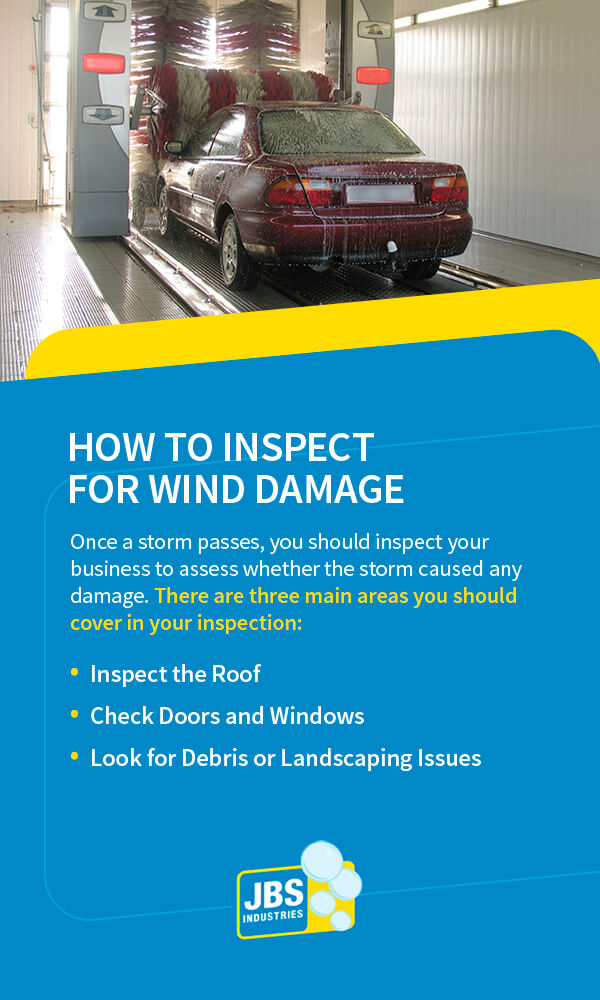
How to Inspect for Wind Damage
Once a storm passes, you should inspect your business to assess whether the storm caused any damage. When you’re prepared for high winds, you may find that all is well after these winds die down, and you can return to business as usual. In some instances, you may find damage that needs to be addressed. There are three main areas you should cover in your inspection — the roof, windows and doors and the surrounding property.
1. Inspect the Roof
The roof is one of the most susceptible places to wind damage, so start here. If you’re doing regular roof inspections, it should be fairly easy to spot if something is out of order on the roof. Some issues, like loose debris on the roof, you can solve immediately. You should also look for signs of damage like:
- Broken, damaged or missing shingles
- Holes or gaps in the roof
- Damaged or missing rooftop equipment
- Debris in spouts and gutters
If you need to replace your roof, consider getting a metal roof since these are known for being more wind-resistant.
2. Check Doors and Windows
Windows and doors can also get damaged during a windstorm, so you should check these parts of your facility, as well. Look for:
- Broken glass
- Cracks or other damage in window frames
- Broken seals letting in water
If a window is broken, you should cover it with a sheet of plywood or a similar material to protect the interior of your building until you can get the window repaired. Try to schedule the repair as soon as possible to maintain your car wash curb appeal.
3. Look for Debris or Landscaping Issues
You should also check the surrounding property to see whether there are any:
- Uprooted or fallen trees
- Broken off branches
- Scattered bits of debris
- Turned over trash cans or other items
Smaller items like branches or trash that are scattered across your property you may be able to pick up and dispose of yourself. However, downed trees are a more serious issue, so you may need to call in a professional to cut up the timber and remove it from the premises.
What if Your Car Wash Experiences Wind Damage?
Even when you’re prepared, wind damage can happen. So, what do you do in this scenario? If one of your insurance policies covers the damage, you will file a claim with the insurance company, letting them know what was damaged in the windstorm. Be sure to take this step right away following the storm if you know you need some serious repairs.
Take pictures of any areas that are damaged since your insurance company may want to see evidence of the damage. If there are temporary steps you can take to secure your building, such as covering a broken window, you can go ahead and do that before your insurance company comes out to assess the damage. In fact, the insurance company will expect you to keep damage from getting worse by covering openings in your building’s exterior or similar problems.
The insurance company may send you a proof of loss form to fill out, or they will schedule a time for an insurance adjuster to come out to your business. The adjuster can guide you through the claims process and will inspect the property to assess the level of damage. In some cases, you may have more than one adjuster come out, each with their own specialization, so they can accurately assess different types of damage.
The assessor or your insurance agent will tell you what to do next. You may need to get an estimate from a local professional for repairs. If you’re ever unsure of what steps you need to take, just check in with your insurance company, and they should help you navigate the process.
For a business, wind damage can have ramifications beyond just the need for repairs. If the damage to your car wash means you have to close temporarily or certain bays are temporarily out of use, then you may also want to file a business interruption claim. To do this, you’ll need to provide records of how much income your car wash was making before the storm compared to now. Your insurer may want to see various financial statements to determine how much income you’re losing due to the wind damage.
JBS Is Your Resource for Car Wash Tips and Superior Soap Products
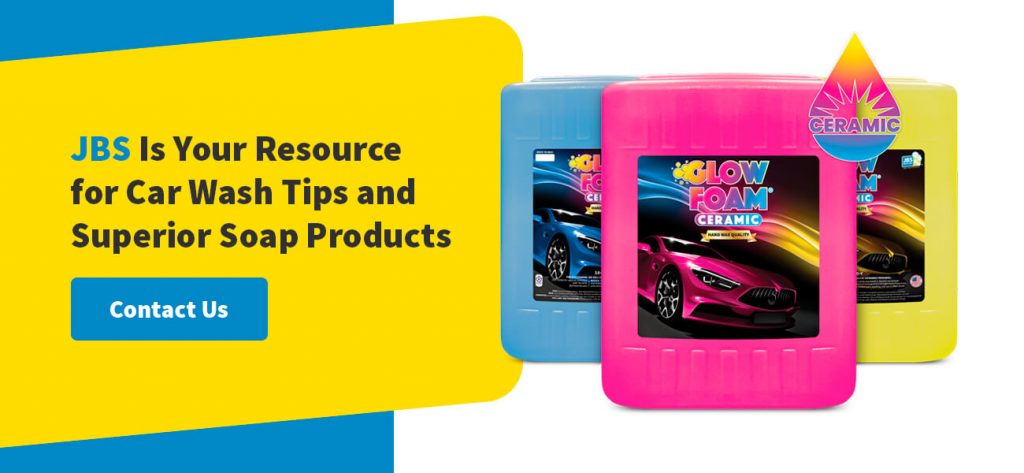
At JBS Industries, we understand the ins and outs of car washes because we’ve been serving the industry for more than four decades. You can browse our blog to learn more tips to help your car wash business succeed.
You can also learn more about our exceptional products. Our pre-soaks, detergents, clear coats and other car wash supplies are all made to be the best on the market. When a customer gets their vehicle washed with these superior products, they’ll notice the difference and will be more likely to come back rather than wash their car at home or take it to another car wash. We even make our products look and smell amazing to enhance the experience your car wash offers. Contact JBS to learn more!

